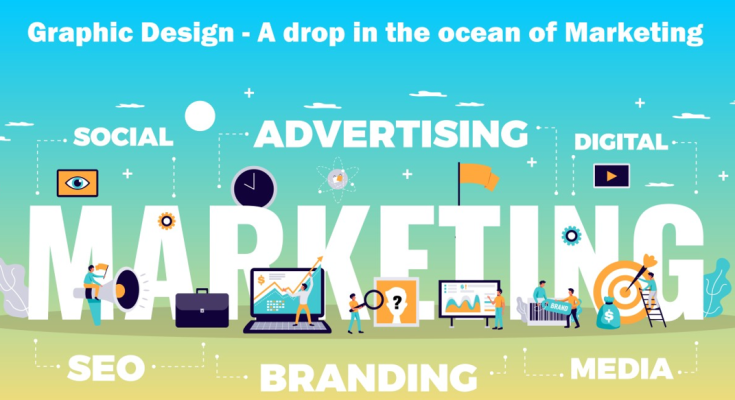Introduction
The Role of Graphic Design in Marketing & Advertising, In the cutting edge world, where purchasers are barraged with endless messages everyday, graphic design has turned into a foundation of compelling marketing and advertising. Visual allure is significant in getting consideration, passing on brand character, and making complex messages open and critical. This guide investigates the effect of visual communication on promoting and publicizing, why it’s fundamental for brand achievement, and how organizations can use plan to make strong, essential missions. Marketing & Advertising.
What Is Visual communication in Showcasing and Advertising?
Visual depiction in showcasing and promoting is the craft of consolidating pictures, message, and thoughts to impart messages to a particular crowd. Dissimilar to unadulterated craftsmanship, which frequently has unassuming understanding, visual computerization has an unmistakable reason: to pass on a message, advance an item, or upgrade brand character. In promoting and publicizing, visual depiction turns into a basic device that effectively illuminates, convince, and have an enduring impact on expected clients. The Role of Graphic Design in Marketing & Advertising. Marketing & Advertising.
The Significance of Visual communication in Marketing
Powerful visual communication can represent the moment of truth a showcasing effort. It upgrades the nature of correspondence, fabricates brand trust, and impacts purchasing conduct. The following are a couple of motivations behind why visual communication is so crucial in showcasing: Marketing & Advertising.
- First Impressions Matter: Great plan quickly catches consideration and conveys amazing skill. It’s generally expected the main collaboration a potential client has with a brand, and a very much planned logo, site, or commercial can establish an uplifting vibe.
- Creates a Predictable Brand Identity: Visual depiction lays out a brand’s visual personality, which incorporates tones, typography, and symbolism. Steady plan components across all advertising materials assist with supporting memorability and lay out trust.
- Improves Lucidness and Message Clarity: Visual computerization sorts out data in a way that is effectively edible. Through plan procedures like differentiation, arrangement, and progressive system, data is organized with the goal that the crowd can rapidly grasp the message.
- Enhances Profound Appeal: Plan decisions like tone, symbolism, and typography bring out feelings. For instance, warm varieties might summon fervor and energy, while cooler tones can convey serenity and incredible skill.
- Increases Commitment and Conversions: An outwardly engaging plan can increment commitment by attracting watchers. Excellent visuals in web-based entertainment posts, email showcasing, and sites are demonstrated to drive more elevated levels of cooperation and, eventually, changes.
Key Parts of Visual computerization in Advertising
Visual computerization in promoting includes numerous components, each filling a novel need in catching consideration and passing on messages. Here is a more critical glance at some center parts:
1. Variety Theory
Variety effectively affects customer discernment. Various varieties inspire various sentiments, which can impact how a brand or item is seen. For instance:
- Red is frequently connected with energy and fervor, settling on it well known for decisions to activity (CTAs).
- Blue conveys trust and solidness, which is the reason numerous monetary establishments use it.
- Green addresses development and wellbeing, frequently utilized by eco-accommodating brands.
Understanding variety hypothesis is fundamental for making plans that line up with brand values and appeal to target crowds. The Role of Graphic Design in Marketing & Advertising. Marketing & Advertising.
2. Typography
Typography assumes a significant part in how a message is seen. Textual style decision can convey a brand’s character, whether it’s cutting edge, customary, lively, or serious. Key parts of typography in publicizing configuration include:
- Text style Selection: Picking text styles that mirror the brand’s tone.
- Hierarchy: Underlining the main data, like headings and CTAs.
- Readability: Guaranteeing the text dimension and dispersing make text simple to peruse across different gadgets.
3. Symbolism and Photography
Pictures are many times more significant than text, making photography and delineations fundamental in promoting. Superior grade, applicable symbolism fortifies messages, assembles a close to home association, and can rapidly convey complex thoughts. For instance, way of life photographs can outline how an item squeezes into day to day existence, while designs and delineations can work on specialized subtleties.
4. Format and Composition
The format of an ad decides how watchers process data. Great organization coordinates components in a manner that normally directs the eye, driving watchers through the substance successfully. Fundamental design standards include:
- Balance: Making congruity by appropriating components equitably.
- Alignment: Guaranteeing that components are outwardly associated for a spotless look.
- Proximity: Gathering related things to fabricate rationality.
5. Iconography and Symbolism
Symbols and images assist with improving on correspondence by addressing thoughts with negligible text. All around planned symbols can rapidly convey complex ideas and make plans really captivating, particularly on computerized stages where space is restricted.
Uses of Visual communication in Promoting and Advertising
Visual communication upgrades different showcasing and promoting mediums, from advanced stages to print media. This is the way configuration adds to various advertising applications:
Virtual Entertainment Marketing
With a great many posts distributed consistently, visual depiction assumes a basic part in aiding content stand apart via online entertainment. Eye-getting visuals empower higher commitment rates, while steady marking assembles acknowledgment. Online entertainment designs might include:
- Marked posts with an unmistakable visual style
- Infographics to introduce information in an open manner
- Merry go round pictures and stories to feature items
- Vivified graphics to catch consideration and make content dynamic
Web architecture and UX
Sites are many times a client’s most memorable prologue to a brand. Great website architecture consolidates stylish allure with usefulness to make a consistent client experience. Visual computerization improves user interface (UI) and user experience (UX) by:
- Making instinctive route that guides clients without any problem
- Improving for versatile and work area to guarantee clarity
- Utilizing visuals like flags, symbols, and recordings to upgrade commitment
Email Advertising Campaigns
Messages with all around planned visuals see higher open rates and navigate rates. Visual computerization in email advertising incorporates:
- Custom email templates for steady marking
- Convincing visuals to feature items or advancements
- Clear CTAs with alluring plan that drives clicks
- Customized plan elements that take care of portioned crowds
Print Advertising
Print advertisements, leaflets, and banners require effective plans to pass on messages obviously and hang out in actual spaces. Components like typography, symbolism, and variety are painstakingly decided to make print promoting powerful. Key print applications include:
- Business cards for systems administration and brand portrayal
- Pamphlets and flyers to give definite item or administration data
- Bulletins and posters that catch consideration with high-influence visuals
Bundling Design
Bundling configuration is basic in retail, as it impacts shopper discernments and buy choices. Through visual depiction, bundling turns into an expansion of a brand’s character and separates it on swarmed racks. Viable bundling configuration includes:
- Clear brand elements (logos, colors, typography) for acknowledgment
- Useful design that features key item benefits
- Engaging visuals that reverberate with the ideal interest group
Tips for Successful Visual communication in Showcasing and Advertising
Making effective visual communication requires a harmony among innovativeness and system. Here are a few ways to accomplish successful plan in showcasing and publicizing:
- Understand Your Objective Audience: Plan ought to be lined up with the inclinations, needs, and upsides of the target group. Understanding where your listeners might be coming from illuminates decisions about variety, style, and symbolism.
- Prioritize Consistency Across Channels: Steady marking across online entertainment, site, print, and different channels supports memorability and assembles trust.
- Keep It Simple: Moderate plan is many times more powerful than jumbled visuals. Keeping plans basic guarantees that the message is clear and simple to process.
- Focus on Coherence and Accessibility: Ensure text is clear across all gadgets and available to everybody, incorporating those with visual weaknesses. This can mean utilizing bigger text styles, higher differentiation, and clear CTAs.
- Test and Refine: Testing different plan varieties takes into consideration execution estimation. Utilize A/B testing, input, and examination to comprehend which plans reverberate best with the crowd.
Conclusion
Visual communication is essential in the present showcasing and publicizing scene. From molding brand personality to further developing client experience, successful plan can drive commitment, improve validity, and at last increment changes. By putting resources into great visual depiction and decisively applying it across all showcasing channels, organizations can make significant, effective missions that hang out in the cutthroat market.


